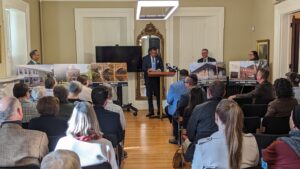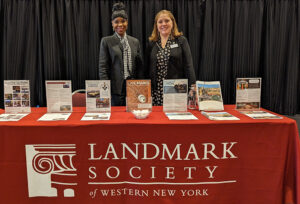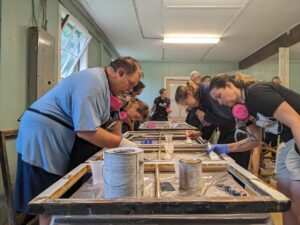
Providing Comfort Heating and Cooling for your Historic House
- November 6, 2009
- 3:14 pm
- November 6, 2009
- 3:14 pm
First in Fall Your Old house Series

On October 19, Landmark Society began its fall series of Your Old House Workshops. The first presenter for the series was Dave Feldman- owner of Feldman Heating and Cooling Inc, a locally renowned HVAC company for over 90 years. Dave brought with him an interesting blend of practice and education to his session. He is an adjunct faculty on the MCC’s HVAC program.
Mr Feldman started his talk with a brief overview of different methods of heating a historic house including wood fireplace, coal stoves, coal fired steams, gravity hot water and warm air. He talked about the advantages of different methods and mentioned that steam has much better distribution and was the premium system till early 1900s. By that time the trades were in place where pipe fitters did plumbing work and sheet metal workers did roofing and architectural sheet metal.
He mentioned about the modernization and the changes due to new technological developments. By mid 1930’s electrification allowed for circulating pumps on hot water systems, electric stokers on coal fired systems and vacuum steam systems. Vacuum steam was a big improvement as it speeded steam distribution and more importantly it allowed the steam temperature to be controlled. Many houses on Sandringham and Ambassador St had this system. After WW II Rochester had many homes converted from coal to either oil or natural gas.
With this background on historic systems, Mr Feldman transitioned into the current heating systems and talked about condensing furnaces, boilers and steam pumps. He stated that the fossil fuel costs have risen in the last few years and the combination of a heat pump and a fossil fuel furnace have proven to increase efficiency.
As for air-conditioning older homes, he cited that comfort cooling is not a matter of temperature reduction. It requires removal of humidity from the air at the same time as the temperature is reduced. Comfort cooling systems may be central, like a traditional ducted forced air system. They could also be specialty ducted such as Unico or Spacepac, or spot cooling may be provided with ductless air conditioning systems such as those from Mitsubishi and Sanyo.
Overall it was an extremely informative session and the interactive nature of the workshop made it all the more engaging. Mr Feldman answered numerous questions from the audience and most attendees enjoyed that. Some questions touched upon important issues like district heat and fuel cells.
Landmark Society would like to thank all the people who attended the session and would encourage them to attend the next sessions too! A special thanks to Mr Feldman for his time, effort and most importantly his understanding, as we faced some technical difficulties during the session and he gracefully took it in his stride. Also not to forget, architects got 2 AIA CES credits for attending one session!
Posted by Nimisha Thakur, Preservation Associate
SHARE




